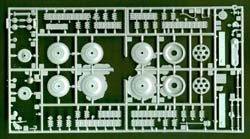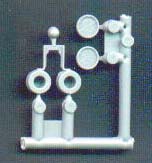EASTERN EXPRESS'S 1/35 SOVIET COMMAND TANK BT-7, MODEL 1935
Kit. No. 35110
MSRP: $30.00
|
 |
History
Next to the T-26 light infantry accompanying tank, the BT fast tank
was the most prolific AFV in the Red Army during the 1930's. The initials
BT form an acronym for Bistrokhodny Tank, or fast tank. It was known among
Soviet tankmen as the Betka (Beetle) or as the Tri-Tankista (Three Tanker)
as the result of its three man crew.
As distinct from most of the other Soviet vehicles at that time, which
were based on the British Vickers models, the BT tank was derived from
an American design by J.W. Christie. This design was also later taken
up by the British to develop their famous Cruiser tank range, the most
famous member being the Crusader. The basic Christie vehicle was purchased
by Soviet officials in America during 1930 and one vehicle was shipped
back to Russia during that year and delivered to the Kharkhov Locomotive
Works. After extensive tests of the Christie vehicle, on 23rd May 1931,
the Revolutionary Military Council of the USSR authorised the tank for
Red Army use and requested its mass production. The drawings for the BT
tank prototype were delivered to the Komintern Factory in Kharkhov during
August of 1931.
On the 3rd of September, 1931 the first two prototypes, designated
BT-1, left the factory gates and were delivered to the Red Army for trials.
This first vehicle was provided with machine-gun armament only, and the
Red Army test commission which investigated the tank requested that the
production modle be armed with an artillery weapon. In the meantime, the
BT-2 model, still with the machine-gun armament, was developed in limited
quantities. After the production of a small number of vehicles, however,
the BT-2 tank received a 37mm Model 1930 tank gun, mounted in the original
machine-gun turret. During 1932, the Red Army requested that the BT tank
be armed with a more powerful weapon, in the form of the 45mm gun. After
various prototypes had been tested, the BT-S model was accepted. This
mounted a 45mm gun in a turret almost identical to that fitted to the
T-26 light tank. A coaxial 7.62mm DT machine-gun was also installed. Commander's
vehicles, which received the suffix "U" or "TU" were provided with two-way
radio equipment, which was mounted in the turret overhang, thereby displacing
some of the 45mm ammunition. As in the cas of the T-26 commander's model,
the turret was fitted with the characteristic frame aerial.
The BT tank was intended for large, independent long-range armoured
and mechanised units (called DD groups). These were to act in the rear
of enemy positions and take out nerve centers such as headquarters, supply
bases, airfields, etc. Under such circumstances, high speed was a great
advantage. One of the basic attributes of the Christie design was the
ability of the tank to run on either tracks or the road wheels. Track
drive was used when moving cross country or along poor roads, whilst wheel
drive was used for long strategic road drives. The time taken to change
from one mode to the other was put between 10 and 15 minutes. This ability
to run on wheels, however, was never actually exploited much by the Red
Army in military operations. When the tank was operated in the wheeled
mode, the tracks were attached along the track guards, and engine power
was transmitted to the rear pair of wheels. The two front road wheels
could be turned to provide steering. In contrast to most other tanks,
where two steering levers were employed, the BT was controlled by a steering
wheel.
As a result of large-scale exercises carried out by the Red Army during
the early 1930s, it was realised that the long-range DD groups required
some form of accompanying artillery to provide artillery fire-support
during the attacks. For this reason, special artillery support tanks,
which received the suffix "A" were developed. The first of these, the
BT5A, was introduced in 1935. It mounted the short-barrelled 76.2mm gun
in a turret very similar to that used as the main one on the T-28 medium
tank. As a result of combat experience, the Red Army requested that the
BT be redesigned with welded armour and that the armor be sloped to increase
its immunity. Thus there emerged the BT-7 model, a vast improvement over
the previous models. Ammuniton stowage comprised 188 45mm rounds and 2,142
7.62mm rounds.
As in the case of the BT-5, a commander's model was developed, designated
BT-7U or BT-7TU. The first series of this vehicle still retained the original
cylindrical turret of the T-26 tank. However, in 1938, following experience
against the Japanese in Manchuria, the new turret..which had been designed
for the T-26 light tank...was also fitted to the BT-7. A commander's version
of this model was also produced. To provide artillery fire-support the
BT-7A version was developed. This had the same turret as the BT-5A. Other
alterations to the BT-7 were the use of a more powerful diesel engine
and an improved transmission system. During 1938, the new V-2 diesel engine
had been developed specifically for tank use, and this was installed in
all subsequent BT-7 tanks. To distinguish it from previous models, the
vehicle was designated BT-7M. It has, however, also been referred to as
the BT-8. This new engine developed 500hp at 1,800rpm, and being a diesel
power-plant allowed the DD groups a much greater range of operation than
had been possible previously. It also reduced the fire risk, since diesel
fuel is not so volatile as petrol.
Several specialised and experimental vehicles were developed from the
BT tank. During 1936, the experimental BT-IS (investigator tank) was developed.
This had heavily sloped armour that shrouded the tracks. This vehicle
contributed greatly to the eventual development of the T-34 tank. During
1937, several BT tanks were equipped with schnorkels, enabling them to
deep-ford water obstacles. Such vehicles were designated BT-5PH. As the
BT-5 and BT-7 models gained numerical significance in the Red Army the
older BT-models were used to develop special-purpose vehicles such as
the BT bridgelayer, smoke tank, and chemical tank.
WHAT'S IN THE BOX:
The kit comes in a lid and tray type box. The kit is one, in a series
of eight, of BT-7 variants that Eastern Express is marketing. These are
kit no. 35108 - an early 1935 version; Kit no. 35109 - a late 1935 version;
Kit no. 35111 - an early 1937 version; Kit no. 35114 - with a 76mm short
barreled KT-28 gun; Kit no. 35113 which is a diesel powered 1939 version;
Kit no. 35116 (not released as yet) which will be a Finnish SPG BT-42
version. Kit no. 35118 a CBT-7 command vehicle on the BT-7 base. Finally,
the subject of this kit: a BT-7-I(V) command version. So, if a modeler
has the money to spare he can do a whole stable of BT-7s. Talk about getting
MILEAGE out of a basic kit mold!!
The kit contains five trees of parts, packaged in three cloudy cello
bags. Parts are molded in a medium gray colored plastic. Moldings are
pretty detailed, for a kit coming from Moscow, Russia. However, there
is quite a bit of flash apparent...especially on the trees that hold the
road wheels, around those road wheels.
Tree "A" holds the bottom, top, and double walls of the sides of the
vehicle. Which must be built into a box. The inside of the inner side
walls have prominent sink marks opposite the girders molded on the outer
suface of them. The driver's hatches and turret hatches can be posed in
the open position, but whether the side walls...with their sinks...will
be viewable after assembly, and leaving these hatches open, will remain
to be seen. If leaving these hatches open, the modeler may want to putty
these sinks. Also, the inner side of the floor of the tank has letter
"A" and Eastern Express Group Russia 2001 molded into it in raised letter.
The modeler may want to sand this off before assembly also.(six pieces
on this tree)
There are two identical letter "B" trees of parts. These contain the
road wheels, idler wheels, drive wheels, link and length type track pieces,
shock absorbers, shovel, stowage boxes, headlights, exhaust parts etc.
Light flash is evident around several of the road wheels. (65 parts per
tree, for a grand total of 130)
Tree lettering now jumps to letter "D" tree. This tree holds the vehicle's
nose, air intake screen, fenders, rear chassis plates, driver's hatches,
suspension parts, horn etc. (28 parts on this tree)
Tree lettering, again, takes a leap to letter "L" tree. This tree holds
the turret sides, top, two different mantles, turret hatches, turret front,
ventilator lid, turret lift rings, and the banister type antenna. I must
say that this tree looked very familiar, as it is the same turret as what
was in the BA-3 Soviet armored car kit that I have (also from Eastern
Express). However, the banister antenna is new.
The final parts are on a tiny tree and packaged in a zip lock cello
bag. These are the parts for the twin spot-light arrangement that mounts
on top of the main weapon. (three parts here)
The decal sheet gives us some wavy red lines, that I gather go around
the turret? A white line, for the same purpose, and a red dotted line
with a white number 12 interrupting it at a couple of points. There are
various circles, both solid and outline type, some red stars, the number
X-16 in white, and what looks to be a turret roof white cross for aerial
identification by friendly forces.
Little or no help is given on the instruction sheet as to how to use
these. What combination? What outfits are they?? This is probably the
weakest point of the kit.
The instructions are printed in Russian and English. It is one large
sheet, folded in the center forming four pages. There are 13 assembly
steps shown. Page one gives a far too short history of the vehicle, followed
by explanations of the international assembly symbols used throughout
the instructions.
The box art will be of no help as far as markings go. It shows a vehicle
with a solid red stripe, at the top of the turret, with a dotted white
stripe below that. This marking is nowhere to be found on the decal sheet
provided! The box painting also shows the BT-7 painted in a two color
wave pattern, which was discontinued very early on, with later war vehicles
painted a solid dark green.
Conclusion
I recommend this kit to modelers of Soviet WWII armor. Outside of no
help with the decal markings, the flash, some sink marks, it is a decent
kit. I would recommend getting some MV brand clear lenses for the headlights
and the searchlights. The solid plastic ones in the kit just don't cut
it for me.
I got this kit at the local shop and will probably pick up one more
version. I don't think I need all 8 that Eastern Express sells.
|








|













